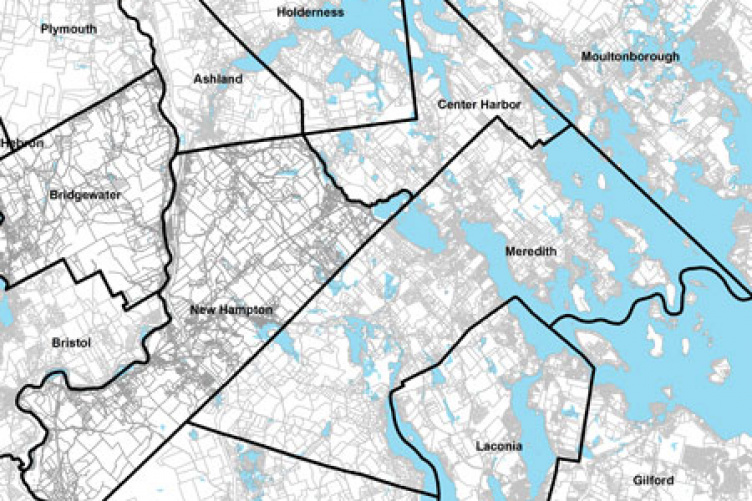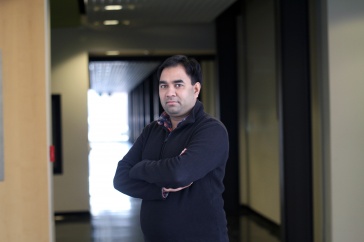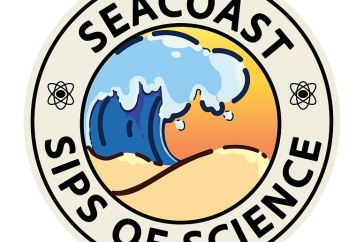
When a tornado ripped through southern New Hampshire in July of 2008, it took 15 people from the state’s Department of Revenue Administration (DRA) working for nearly three weeks to assess the damage in order to apply for federal disaster relief.
Now, thanks to a collaborative effort between the state and the University of New Hampshire, officials could assess maximum damage totals from the next tornado or other disaster in just five minutes, without ever leaving their offices. The Mosaic Parcel Map, a project of UNH’s Technology Transfer Center, merges the tax maps of all 234 municipalities and 22 unincorporated areas in the state to create the first sustainable statewide parcel map in the nation.
The Mosaic Parcel Map knits together each towns’ property maps– some of them still existing on paper or Mylar in town halls across the state – into a single digital file. Connected to each parcel, or property, is essential information gleaned from towns’ computer assisted mass appraisal (CAMA) systems, including property location and boundaries, ownership, date of sale, land area, building area, and land and building assessments.
It’s an achievement nearly two decades in the making, says UNH professor of civil engineering Charles Goodspeed, director of the Technology Transfer Center, or T2, and one that amassed many naysayers. “We got nowhere for years,” he says, both because the idea outpaced technology and because political will to move it forward was lacking. After conducting a successful pilot project with the New Hampshire Department of Transportation and seven towns that abut each other, “the DRA got quite excited,” Goodspeed says. The $1.3 million project is funded with state capital improvement money via DRA.
|
|
“The [UNH Technology Transfer] center has performed far beyond the department’s expectations and has delivered the highest quality products, on time and on budget,” DRA director Kevin Clougherty says. “Having the center as our working partner has allowed us to collect local data from a neutral standpoint, without some of the normal misgivings about inter-government cooperation.”
While the map is being used for many purposes by many state agencies, disaster is what resonates with individual towns. When a natural disaster strikes, the DRA must assess damage costs in order to apply for relief, a task that previously involved contacting individual towns affected. But floods and tornadoes don’t respect municipal boundaries, and “good luck finding someone to talk to, when the town hall is open from six to eight on Wednesday nights,” says Mosaic project manager David Salzer, a Ph.D. student in civil engineering, of some of the Granite State’s smaller towns.
To make Mosaic effective, the team, which also includes Ph.D. student Pat Santoso and Stephan Hamilton of the DRA with assistance from UNH’s Research Computing & Instrumentation, overcame the incompatibility of each towns’ data as well as towns’ concerns about participating. The reputation of T2, which had worked with many municipalities throughout its 25-year history, helped smooth the way, and Goodspeed says they assured towns their data would not be available to commercial interests (Northern Pass and cell phone companies looking to install towers are some that have asked). While all the data is publicly available from individual towns, “we’re not going to provide it on a golden platter to commercial use,” Goodspeed says. “UNH’s credibility is extremely high with confidential material.”
Key to the project’s success, the researchers say, is its sustainability: With the state’s 10 deeds offices supplying daily purchase-and-sales data and municipalities reporting additional data annually, the Mosaic map remains current. In exchange, the project supplies towns with standardized datasets they can use for regional planning efforts.
The three-year contract has benefitted UNH as well as local and state governments. “It’s really been integrated into our academic program,” Goodspeed says, noting that in addition to Salzer and Santoso, Mosaic employs four master’s students and 10 undergraduates. “We’re very inexpensive compared to a consulting company,” he adds.
Mosaic was recently recognized as a “Bright Idea” by the Harvard University Kennedy School of Government’s Ash Center for Democratic Governance and Innovation. “It’s gained a lot of national traction,” says Salzer. “It’s shown other states that for relatively little money a project like this can be executed.”
“We’ve shown everyone in the state what can be done with good maps and data,” Goodspeed says.
Originally published by:
UNH Today




















































